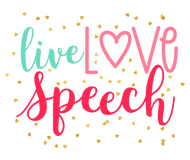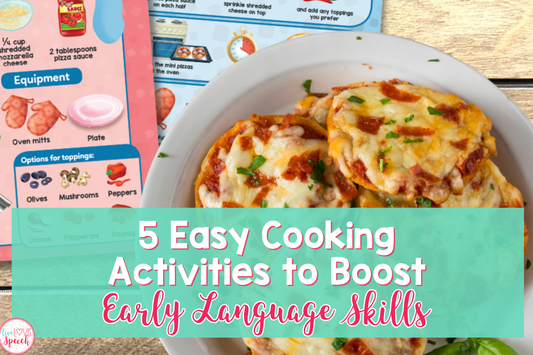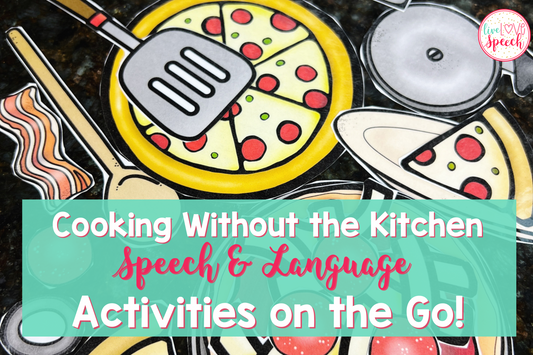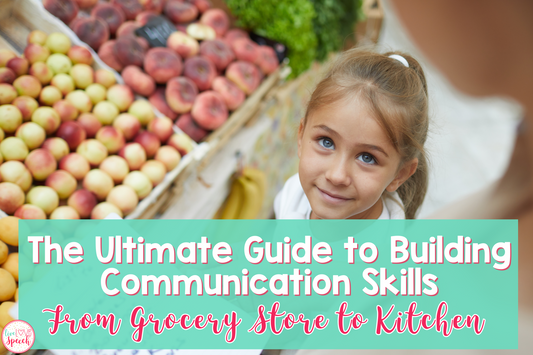
Cooking has always been a regular part of my routine, especially with my son Landon. He loves helping in the kitchen, and we’ve turned it into more than just a cooking session! But a meaningful way to learn and bond.
Whether it’s mixing, measuring, or (of course) taste-testing, we find ways to make the experience fun and educational.
One of my favorite skills to work on during our kitchen time is phonological awareness! Helping kids recognize and play with sounds in words. With a little creativity, cooking becomes the perfect setting for simple, hands-on phonological awareness activities. Let me show you how!
Why Cooking Is Perfect for Speech Practice
Cooking combines sensory experiences with language-rich opportunities. From hearing the sizzle of a pan to describing the texture of ingredients, it’s a hands-on way to make speech practice interactive.
Plus, everyday kitchen tasks often involve sequencing, vocabulary building, and sound awareness, making it an ideal setting for learning.
Activities to Build Phonological Awareness
Here are some of our favorite ways to make cooking time a learning opportunity. Each activity is simple to set up, engaging for kids, and perfect for practicing key phonological awareness skills.
1. Clapping Syllables in Ingredients
Materials Needed: Ingredients and tools for a simple recipe (e.g., Football Krispie Treats, Penguin Cookies, Cupid's Shake, or Valentine's Day Snack Mix), optional Visual Recipe Cards.

Process:
- Pick a no-cook recipe to prepare with your child. You can create your own simple recipe or use one from the No-Cook Visual Recipes as a guide. Gather the listed ingredients and tools.
- As you prep, have your child clap out the syllables for each ingredient or tool. For example:
- "Foot-ball Kris-pie Treats" (5 claps)
- "Cook-ie" (2 claps)
- "Pea-nut But-ter" (4 claps)
- If using the Visual Recipe Cards, show the corresponding card for each ingredient or tool as your child says and claps the word.
- Extend the activity by clapping syllables for actions as you follow the steps in the recipe:
- "Mix-ing" (2 claps)
- "Pour-ing" (2 claps)
- For added fun, make it a challenge by speeding up the clapping or breaking longer words into smaller parts.
This activity helps kids break down words into manageable parts, a key skill in phonological awareness.
Learn more about my February Visual Recipes here!
2. Rhyming Recipe Game
Materials Needed: Recipe ingredients, optional rhyming word list.
Process:
- Before starting a cooking step, pick an ingredient or action and say its name aloud. For example: “Cake.”
- Challenge your child to come up with words that rhyme with it. Encourage them to use both real and nonsense words—“Bake, rake, lake, make!”
- For a twist, give them a rhyme and ask them to find the matching ingredient. For example: “What rhymes with ‘pie’? Oh, yes! Fly—and pie!”
- Incorporate this into the cooking process by pausing for a quick rhyme game before each step.
This game strengthens auditory discrimination and sound play while keeping things lighthearted and fun.
3. Sound Sorting While Prepping
 Materials Needed: Ingredients and tools for one of the January Visual Recipes (e.g., Popcorn Snowballs, Polar Bear Snack, Frozen Hot Chocolate, or Melted Snowman), sorting bowls or plates, Visual Recipe Cards (optional).
Materials Needed: Ingredients and tools for one of the January Visual Recipes (e.g., Popcorn Snowballs, Polar Bear Snack, Frozen Hot Chocolate, or Melted Snowman), sorting bowls or plates, Visual Recipe Cards (optional).
Process:
- Choose a recipe from the January Visual Recipes and gather the listed ingredients and tools. Use the shopping list or visuals provided to help kids identify the items.
- Place the ingredients and tools on the counter and encourage your child to sort them based on their initial sounds.
"What starts with /p/? Popcorn, peanut butter!"
"What starts with /s/? Sugar, spoon!"
- Use the Vocabulary Cards included in the resource to reinforce ingredient names and actions. For example, show the card for "spoon" while emphasizing its beginning sound.
- Extend the activity by discussing the sounds in the recipe steps as you follow the directions. For example: “What sound does ‘stir’ start with?”
This activity not only helps kids identify beginning sounds but also reinforces vocabulary, sequencing, and following directions in a fun and practical way. With the Visual Recipes, it’s easier than ever to combine phonological awareness with meaningful cooking activities!
Check out my January Visual Recipe Cards Here
4. Alliteration Cooking Challenge
 Materials Needed: Recipe ingredients, optional list of alliterative phrases.
Materials Needed: Recipe ingredients, optional list of alliterative phrases.
Process:
- Choose a letter sound for the challenge (e.g., /p/).
- Look at the recipe together and create an alliterative theme. For example, “Pancakes with Peaches” or “Perfectly Prepped Pasta.”
- As you cook, keep the alliteration going! For example, when cooking eggs, try “Cut, Crack, Cook” to match the /k/ sound.
- Ask your child to come up with their own alliterative phrases for the steps.
This playful activity highlights the repetition of sounds, building sound awareness and creativity.
5. Sound Scavenger Hunt
Materials Needed: Ingredients and tools for a recipe (e.g., Football Krispie Treats, Penguin Cookies, Cupid's Shake, or Valentine's Day Snack Mix), optional Visual Recipe Cards.
Process:
- Before starting the recipe, set up a "sound scavenger hunt" using the ingredients and tools. Place them around the kitchen or in a designated area.
- Give your child clues to find each item based on its initial sound. For example:
- “Find something that starts with /p/” (Peanut butter, popcorn).
- “What starts with /m/?” (Marshmallows, measuring cup).
- For extra practice, have your child say the sound and name the item after finding it.
- If using the Visual Recipe Cards, display the item’s corresponding card once it’s found to reinforce vocabulary.
- Wrap up the scavenger hunt by bringing all the items to the counter and starting the recipe together.
This activity helps kids listen for and identify beginning sounds in words.
Need More Practice with Phonological Awareness?
 If you're looking for more ways to boost phonological awareness, check out my Grab N' Go Phonological Awareness Task Cards! This resource is packed with evidence-based activities designed to help your child with key phonological skills, including:
If you're looking for more ways to boost phonological awareness, check out my Grab N' Go Phonological Awareness Task Cards! This resource is packed with evidence-based activities designed to help your child with key phonological skills, including:
- Syllable Identification
- Phoneme Matching & Identification
- Rhyming
- Blending & Segmenting Sounds
- Phoneme Substitution, Addition & Deletion
The task cards come with visual answer choices and are perfect for on-the-go therapy, RTI, or center activities. Each set of cards is designed to make phonological practice fun and engaging while tracking progress with easy-to-use data sheets.
Ready to get started?
Grab your set of Grab N' Go Phonological Awareness Task Cards now!
Helpful Tips for Using Phonological Awareness Activities
- Start Simple: Begin with simple, easy-to-identify sounds and build from there. Start with initial sounds and progress to more complex tasks like phoneme substitution.
- Make It Interactive: Use props, like bingo daubers or play-doh, to make the activities engaging and hands-on.
- Track Progress: Use the provided data sheets to monitor your child’s progress. It helps you see how much they’ve improved over time!
- Consistency is Key: Short, consistent practice sessions will yield the best results. Try to incorporate phonological awareness activities into your routine a few times a week.
- Cooking Safety First: When doing cooking activities with kids, always supervise them closely. Ensure they know basic kitchen safety, like handling knives carefully, using oven mitts for hot items, and washing hands before and after food prep. For more tips on safety visit my blog here!
These tips can help you make the most of your phonological awareness practice and ensure that learning stays fun and engaging!
Remember, consistency and fun are key to helping kids develop their phonological awareness. Always make sure to keep safety in mind when doing any cooking activities, and don’t forget to track progress to celebrate their improvements!
For more ideas, tips, and resources, be sure to check out my blog posts. Let's keep making learning enjoyable for both you and your child!





